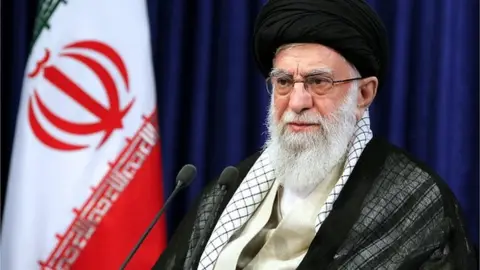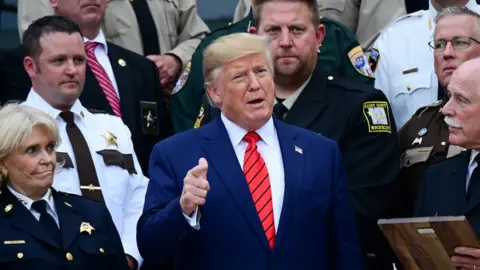Iran blocking sites access, UN nuclear watchdog says
 Getty Images
Getty ImagesThe UN nuclear watchdog has expressed serious concern at Iran's continuing failure to allow access to sites the agency wants to visit.
The International Atomic Energy Agency (IAEA) says that for more than four months Iran has been blocking inspections of two suspect locations.
It is believed the activity there took place long before Iran agreed to curb its nuclear ambitions in a 2015 deal.
The IAEA says Iran's enriched uranium stockpile now exceeds the agreed limit.
The findings, laid out in two unreleased reports, are expected to be discussed by the agency in mid-June.
It comes amid rising tensions between Iran and the US, which pulled out of the 2015 international agreement.
Iran has always denied that it has ever sought to develop a nuclear weapon, insisting that its programmes have been peaceful.
What are the findings?
In a new report, the Vienna-based IAEA notes "with serious concern" that it has been barred entry to two locations in Iran.
According to AFP news agency, the nuclear watchdog believes one of the sites "may have been used for the processing and conversion of uranium ore" in 2003.
It also said a third site with a possible presence of undeclared uranium underwent "extensive sanitisation and levelling in 2003 and 2004".
The IAEA did not publicly name the three sites.
A separate report says that Iran held 1,571.6kg (3,464.7lb) of low-enriched uranium as of 20 May - well above the agreed 300kg limit.
The highest level of enrichment in the stockpile is 4.5%, breaching the agreement's 3.67% limit. It is still, however, below the level required to create fissile material for a nuclear weapon.
A diplomatic source told AFP that Iran's rate of enrichment has not significantly changed since the IAEA's earlier report in March.
The agency said it still has access to all nuclear sites needed to monitor Iran's current nuclear activity, despite difficulties caused by the coronavirus pandemic, and noted "exceptional co-operation" by Iranian authorities.
What is the Iran nuclear deal?
The deal was signed in 2015 by Iran and China, France, Germany, Russia, the UK and the US. Under the deal, Tehran agreed to curb its nuclear activity in return for the lifting of sanctions.
Although the agreement allowed Iran to accumulate small amounts of uranium for research, it banned the enrichment of uranium, which is used to make reactor fuel but also, potentially, nuclear weapons.
Iran was also required to redesign a heavy-water reactor being built, whose spent fuel would contain plutonium suitable for a bomb, and to allow international inspections.
 Reuters
ReutersThe agreement was hailed as a landmark - but in May 2018, President Donald Trump abandoned the deal, which he criticised as flawed, and reinstated US sanctions.
That same month, the US tightened its sanctions against Iran and said it would attempt to force all countries to stop buying Iranian oil and put pressure on Iran to negotiate a new nuclear accord.
Since sanctions were tightened, Iran has been steadily breaking some of its commitments to pressure the remaining signatories to find a way to provide sanctions relief.
In January 2020, European powers triggered a formal dispute mechanism over Iran's breached of the deal - a move that could spell its end.
